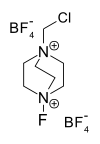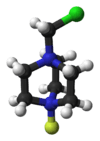Selectfluor
| |||
| Names | |||
|---|---|---|---|
| IUPAC names
1-(chloromethyl)-4-fluoro-1,4-diazo niabicyclo[2.2.2]octane ditetrafluoroborate | |||
| Other names
F-TEDA, N-Chloromethyl-N-fluorotriethylenediammonium bis(tetrafluoroborate) | |||
| Identifiers | |||
| 140681-55-6 | |||
| ChemSpider | 2007047 | ||
| EC number | 414-380-4 | ||
| |||
| Jmol-3D images | Image | ||
| PubChem | 2724933 | ||
| |||
| Properties | |||
| C7H14B2ClF9N2 | |||
| Molar mass | 354.26 g/mol | ||
| Appearance | colourless solid | ||
| Melting point | 234 | ||
| Except where noted otherwise, data is given for materials in their standard state (at 25 °C (77 °F), 100 kPa) | |||
| | |||
| Infobox references | |||
1-Chloromethyl-4-fluoro-1,4-diazoniabicyclo[2.2.2]octane bis(tetrafluoroborate) or Selectfluor, a trademark of Air Products and Chemicals, is a reagent in chemistry that is used as a fluorine donor. This compound is a derivative of the heterocycle DABCO . This colourless salt was first described in 1992[1] and has since been commercialized for use in organofluorine chemistry for electrophilic fluorination.
Preparation
Selectfluor is synthesized by the N-alkylation of diazabicyclo[2.2.2]octane (DABCO) with dichloromethane, followed by ion exchange with sodium tetrafluoroborate (replacing the chloride counterion for the tetrafluoroborate). Finally, this salt is treated with elemental fluorine and sodium tetrafluoroborate:[1]
Applications
The conventional source of "electrophilic fluorine," i.e. the equivalent to the superelectrophile F+, is gaseous fluorine, which requires specialised equipment for manipulation. Selectfluor reagent is a salt, the use of which requires only routine procedures. Like F2, the salt delivers the equivalent of F+. It is mainly used in the synthesis of organofluorine compounds:[2][3][4][5]

Specialized applications
Selectfluor reagent also serves as a strong oxidant, a property that is useful in other reactions in organic chemistry. Oxidation of alcohols and phenols. As applied to electrophilic iodination, Selectfluor reagent activates the I2 bond.
References
- ↑ 1.0 1.1 Banks, R. Eric; Mohialdin-Khaffaf, Suad N.; Lal, G. Sankar; Sharif, Iqbal; Syvret, Robert G. (1992). "1-Alkyl-4-fluoro-1,4-diazoniabicyclo[2.2.2]octane salts: a novel family of electrophilic fluorinating agents". Journal of the Chemical Society Chemical Communications (8): 595. doi:10.1039/C39920000595.
- ↑ Banks, R. Eric; Besheesh, Mohamed K.; Mohialdin-Khaffaf, Suad N.; Sharif, Iqbal (1996). "N-Halogeno compounds. Part 18. 1-Alkyl-4-fluoro-1,4-diazoniabicyclo[2.2.2]octane salts: user-friendly site-selective electrophilic fluorinating agents of the N-fluoroammonium class". Journal of the Chemical Society Perkin 1: 2069–2076. doi:10.1039/P19960002069.
- ↑ Manral, Laxmi (2006). "Selectfluor (F-TEDA-BF4) C7H14B2ClF9N2". Synlett (5): 0807. doi:10.1055/s-2006-933124.
- ↑ Stojan Stavbera and Marko Zupana (2005). "Selectfluortm F-TEDA-BF4 As a Versatile Mediator or Catalyst in Organic Chemistry" (PDF). Acta Chim. Slov. 52: 13–26.
- ↑ Singh, R.P.; Shreeve, J. M. (2004). "Recent Highlights in Electrophilic Fluorination with 1-Chloromethyl-4-Fluoro-1,4-Diazoniabicyclo[2.2.2]Octane Bis(Tetrafluoroborate)". Acc. Chem. Res. 37 (1): 31–44. doi:10.1021/ar030043v. PMID 14730992.
Other References
- Lal, G. S., J. Org. Chem. 1993, 58, 2791.
- Lal, G. S., Synth. Commun. 1995, 25 (5), 725.
- Banks, R. E.; Lawrence, N. J.; Popplewell, A. L., J. Chem. Soc., Chem. Commun. 1994, 343.
- Banks, R. E., J. Fluorine Chem. 1998, 87, 1.
- Zupan, M.; Iskra, J.; Stavber, S., J. Fluorine Chem., 1995, 70, 7.
- Matthews, D.P.; Miller, S. C.; Jarvi E. T.; Sabol, J. S.; McCarthy, J. R., Tettrahedron Lett. 1993, 34 (19), 3057.
- Brunaus, M.; Dell, C. P.; Owton, W. M., J. Fluorine Chem. 1994, 201.
- McClinton, M. A. ; Sik, V., J. Chem. Soc., Perkin Trans. I, 1992, 1891.
- Hodson, H. F.; Madge, D. J.; Slawin, A. N. Z.; Widdawson, D. A.; Williams, D. J., Tetrahedron, 1994, 50 (6), 1899.
- Stavber, S.; Zupan, M., J. Chem. Soc., Chem. Commun. 1994, 149.
- Stavber, S.; Sotler, J.; Zupan, M., Tettrahedron Lett. 1994, 35 (7), 1105.
Patents
- US 5459267 "1-substituted-4-fluoro-1,4-diazoniabicyclo[2.2.2]octane salts and their application as fluorinating agents"
- US 55227493 "Fluorinated Sulfonamide Derivatives"
- US 5086178 "Fluorinated Diazabicycloalkane Derivatives"
- US 5473065 "Fluorinated Diazabicycloalkane Derivatives"
- US 5442084 "Method of Selective Fluorination"


